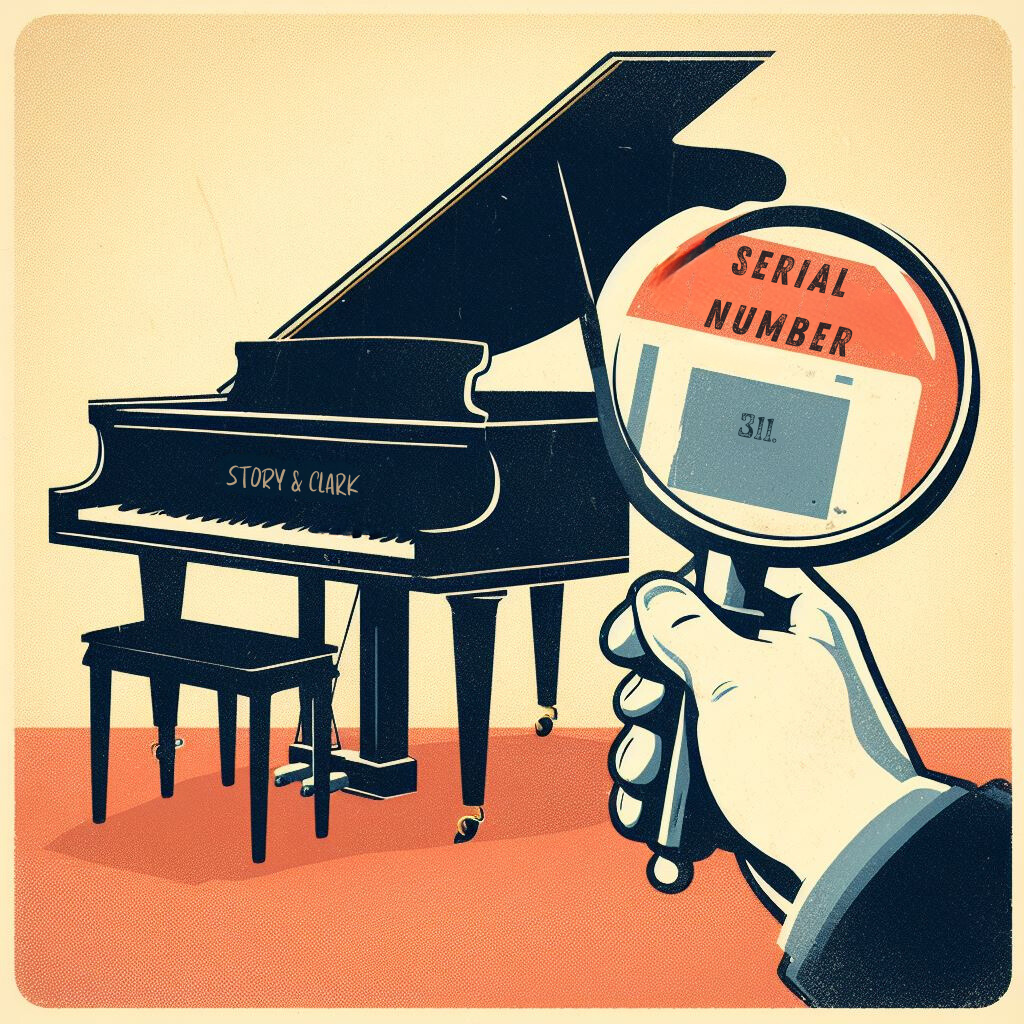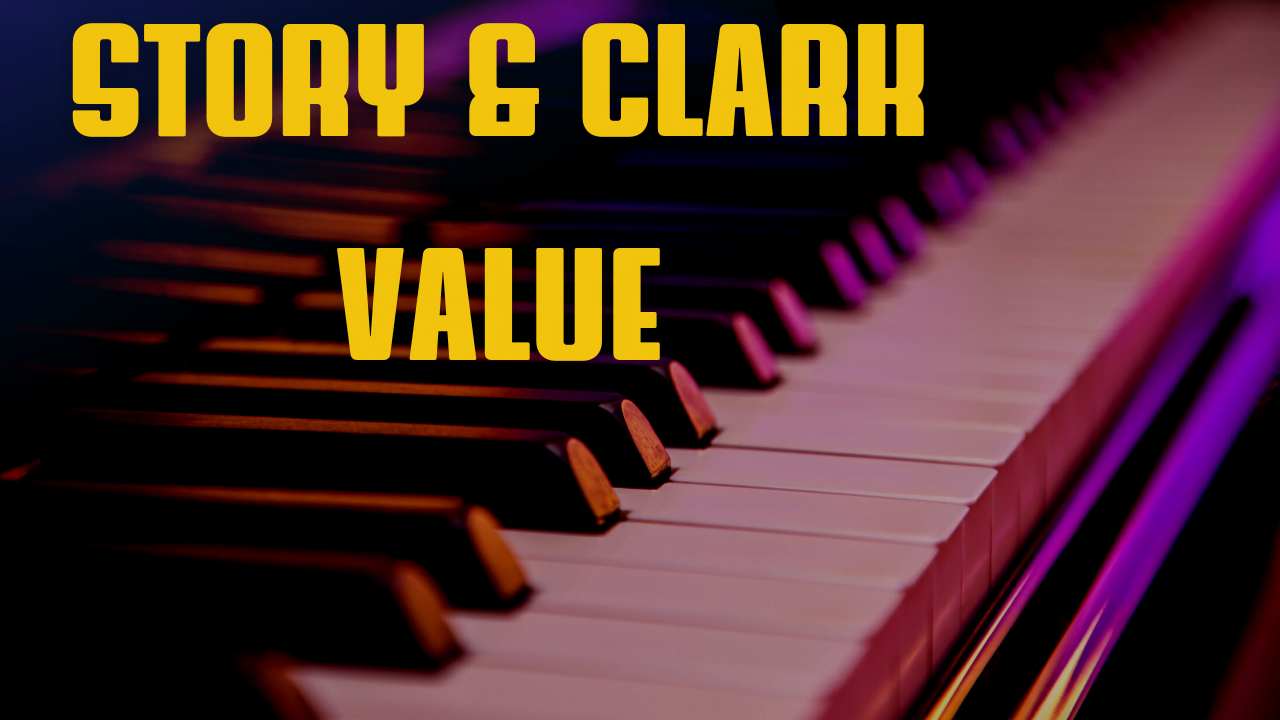Story & Clark pianos have a rich history in American piano making. With origins dating back to the 1850s, these instruments were made by skilled craftsmen and produced beautiful music in households across the country.
When assessing the value of a Story & Clark piano, there are several key factors to consider including age, condition, rarity, and restoration status. This comprehensive guide will provide an in-depth look at determining the value of these historic pianos.
A Brief History of Story & Clark Pianos

The Story & Clark Piano Company was founded in 1857 by two entrepreneurs, Elias Story and Melville Clark. The company was located in Chicago and aimed to produce high-quality yet affordable pianos for the everyday home.
Story & Clark pioneered the use of a full metal plate in their pianos, adding stability and improving tuning stability. This was an important innovation at the time. They also focused on consistent quality, producing pianos renowned for their rich tone and precise action.
The company was successful and expanded production in the early 1900s. Story & Clark would go on to become the largest piano maker in the United States by the 1920s. They continued making pianos until the 1960s when economic factors led to the company’s closure.
Key Factors Influencing Value

There are several important considerations when determining the value of a Story & Clark piano. These include:
Age
- Older Story & Clark pianos tend to be more valuable, especially instruments from the early 20th century.
- Pianos from the 1920s and 1930s are generally worth more than later models.
- Condition being equal, earlier models are more prized by collectors and players.
Condition
- Excellent condition with no restoration provides maximum value.
- Any damage, disrepair or deterioration will decrease value.
- Functional parts like keys, hammers, and strings significantly impact playability and value.
- Cosmetic condition of the cabinetry is also important.
Rarity
- Certain Story & Clark models are rarer and more collectible than others. This can increase value.
- Unique or custom features also make a piano more valuable.
- Mass produced models from later years are less rare than earlier limited production runs.
Restoration
- Professional restoration can greatly increase value but also costs thousands of dollars.
- Restored instruments will be worth more than similar unrestored pianos.
- Restoration should be high quality and period-appropriate.
Typical Value Range by Type
Story & Clark produced a range of piano types over their 100+ year history. The typical value range can vary significantly depending on the instrument.
Vertical Pianos
Upright pianos were the most common Story & Clark instruments. Value ranges:
- Unrestored uprights – $200 to $850 depending on exact age and condition.
- Restored uprights – $1,000 to $4,000 depending on model and restoration quality.
Spinets
Compact spinets were popular Story & Clark models, slightly smaller than uprights. Value range:
- Unrestored spinets – $300 to $600 depending on age and condition.
- Restored spinets – $800 to $2,500 depending on model and restoration.
Consoles
Console pianos feature elegant cabinetry with legs. Value ranges:
- 1920s-1930s consoles – $400 to $1,200 unrestored, higher restored.
- 1960s consoles – $300 to $500 unrestored. Less valuable than earlier consoles.
Grand Pianos
Larger horizontal grand pianos are less common from Story & Clark. Value range:
- 1920s-1930s grand pianos – $1,500 to $4,000 unrestored, significantly more when restored.
- Rare grand models – Certain antique grands can be worth over $10,000 restored.
How to Estimate Piano Value

Determining the value of a Story & Clark piano involves research and expert assessment. Here are some tips:
- Find the serial number – This helps determine manufacturing date which impacts value.
- Research recent sales – Look at comparable pianos sold recently to gauge value.
- Assess condition – Consider age, damage, restoration needs and playability.
- Consult professionals – Tuners, restorers and appraisers can provide valuation guidance.
- Account for depreciation – Older pianos lose value over time, factor this in.
- Get an appraisal – For the most accurate value, hire an experienced piano appraiser.
Where to Sell Your Story & Clark Piano

Once you’ve determined the value of your Story & Clark piano, here are some options for selling it:
- Piano stores – Many piano retailers buy used instruments. They may pay wholesale prices.
- Online marketplaces – List the piano for sale on Craigslist, Facebook Marketplace or eBay.
- Consignment – Musical instrument shops sometimes sell pianos on consignment for a fee.
- Auction houses – Specialized auctioneers can help sell rare, high-value pianos to collectors.
- Piano dealers – There are dealers who focus exclusively on buying/selling used pianos.
- Classified ads – Advertise in classified sections of local newspapers and magazines.
Is Restoration Worth the Investment?

Restoring a Story & Clark piano can greatly increase its value but also costs thousands of dollars. Here are some factors to help decide if restoration is a wise investment:
- Assess restoration costs – Get quotes from reputable technicians to estimate costs.
- Evaluate potential value increase – Will restoration significantly boost value beyond the cost?
- Consider personal value – Decide if an improved family heirloom is worth the expense.
- Determine playability – Will new strings, hammers and repairs make the piano more playable?
- Consult experts – Ask piano restorers if restoration is advisable based on piano’s condition.
- Factor in future sales – A restored piano will command higher prices when selling.
- Choose restoration strategically – Prioritize work with the biggest impact on playability and value.
In many cases, full restoration maximizes the value of a Story & Clark piano. But it can also become a money pit if costs exceed the piano’s fair market value. Carefully weighing these considerations helps determine if restoration is a wise investment.
Maintaining Value After Restoration

Once a Story & Clark piano is restored, proper maintenance is essential to preserve its value. Recommended care includes:
- Climate control – Keep the piano away from extreme temperatures and humidity.
- Tune regularly – Plan on tuning at least twice a year to maintain tone.
- Regulate periodically – Regulation keeps the intricate mechanisms working properly.
- Clean regularly – Dusting and cleaning prevents buildup of dirt and debris.
- Avoid direct sunlight – Fade and damage can occur from prolonged direct sunlight.
- Mind the humidity – Use humidifiers and dehumidifiers to maintain 40-60% humidity.
- Play gently – Avoid aggressive playing which can damage the piano’s action.
With the right climate conditions and regular care, a restored Story & Clark piano can maintain its increased value for many years to come.
Final Takeaways
Story & Clark pianos have long been prized for their excellent construction and musical tone. When assessing their value, age, condition, rarity and restoration status are key factors to consider. Restoration can greatly boost value but also requires a significant investment. With proper maintenance, these instruments can deliver beautiful music and retain their value for generations.
For piano owners, understanding what impacts your Story & Clark piano’s value enables making informed decisions when purchasing, caring for, restoring or selling the instrument. This comprehensive guide provides crucial insights into preserving and maximizing the value of these historic American pianos.
FAQs
Q: What is the value of a Story & Clark Piano?
A: The value of a Story & Clark piano can vary depending on several factors such as its age, condition, and model. It is best to have a qualified piano technician or appraiser assess your specific instrument to determine its current value.
Q: How can I determine the value of my piano?
A: To determine the value of your Story & Clark piano, you can consider factors such as its age, condition, model, and current market demand. It is recommended to consult a qualified piano technician or appraiser for an accurate assessment.
Q: What is the serial number of my Story & Clark piano?
A: The serial number of a Story & Clark piano can be found on the back of the instrument, typically engraved on a metal plate. You may need to open the piano lid to access the serial number.
Q: How do I find the serial number of my Clark upright piano?
A: The serial number of a Clark upright piano is usually located on the back of the instrument, engraved on a metal plate. You may need to open the piano lid to access the serial number.
Q: Can you determine the price of my Story & Clark piano?
A: Unfortunately, we cannot provide a specific price for your Story & Clark piano without assessing its condition, age, model, and market demand. It is recommended to consult a qualified piano technician or appraiser for an accurate price estimate.
Q: What is the current value of a Story & Clark baby grand piano?
A: The current value of a Story & Clark baby grand piano can vary depending on its age, condition, and market demand. It is advised to consult a qualified piano technician or appraiser for an accurate valuation.
Q: How can I determine the brand of my piano?
A: The brand of your piano can usually be found on the fallboard or cast iron plate. Look for the manufacturer’s name, such as “Story & Clark,” engraved or stamped on these areas.
Q: Does Story & Clark produce player pianos?
A: Yes, Story & Clark has produced player pianos in the past. If you have a Story & Clark player piano, it might have additional features and capabilities for playing piano rolls.
Q: Is my Story & Clark piano in good condition?
A: Assessing the condition of a piano requires a thorough examination by a qualified piano technician or appraiser. They will evaluate factors such as the instrument’s mechanical components, tone, and overall appearance to determine its condition.





